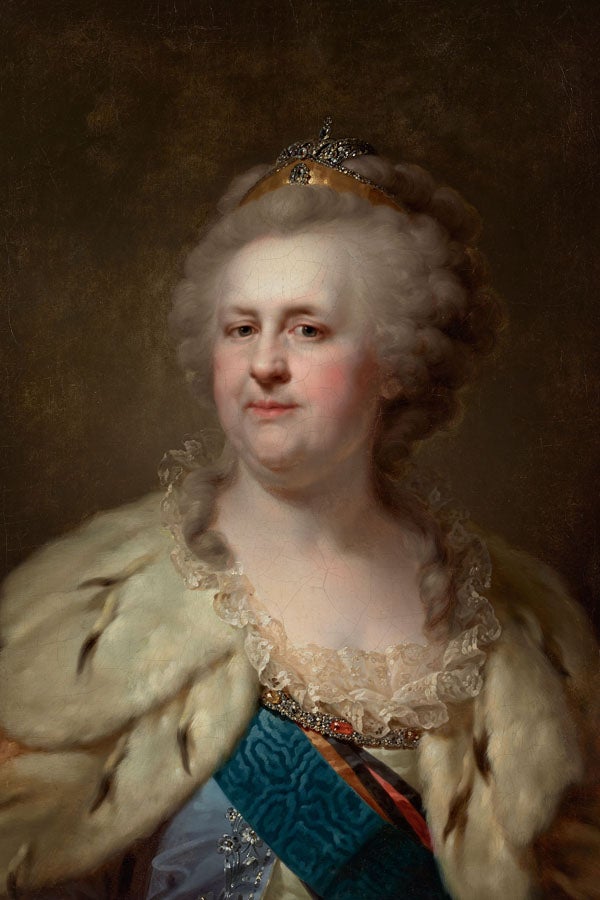September 21, 2017
Hoover Institution, Cantor Arts Center create new exhibition to mark centenary of 1917 Russian Revolution
A new exhibition at the Cantor Arts Center and at the Hoover Institution Library & Archives will open Oct. 18 to showcase Stanford’s rich collections of art and materials related to late imperial and early Soviet Russia.
By Alex Shashkevich
This fall marks 100 years since the Russian Revolution of 1917 ushered in the fall of the last Russian czars and the rise of the first Soviet commissars.

This portrait of Catherine the Great was painted by Johann Baptist von Lampi “The Elder,” circa 1790. (Image credit: Nikolai Aleksandrovich Bazili papers, Hoover Institution Archives)
Marking the anniversary, the Cantor Arts Center and the Hoover Institution Library & Archives have partnered to create a joint exhibition highlighting Stanford’s rich collections of artworks, archival documents and rare books related to late imperial and early Soviet Russia.
The Crown under the Hammer: Russia, Romanovs, Revolution, which opens Oct. 18 and lasts through March 4, will be displayed at both the Cantor Arts Center and the Hoover Institution.
The featured items, some of which have not been displayed before, are drawn largely from the Hoover Institution Library & Archives, as well as from Stanford University Libraries’ Special Collections, the Bowes Art & Architecture Library and the Cantor.
The Cantor’s display will juxtapose different types of works to demonstrate the dramatic cultural shifts that took place in Russia in the first decades of the 20th century. Easel paintings depicting Russian royalty and reflecting their respect for tradition will be shown in contrast to mass-produced posters and printed matter that represent the Soviet regime’s forward-looking perspective and revolutionary agenda.
“For a brief period after the revolution, the Soviet state supported remarkable avant-garde artists who worked in a variety of media and embraced the most cutting-edge visual languages of the day,” said Jodi Roberts, the Robert M. and Ruth L. Halperin Curator for Modern and Contemporary Art at the Cantor and a co-curator of the exhibition. “The marriage of progressive aesthetics and radical politics in the early revolutionary years continues to inspire creative thinkers today.”
The installation at the Hoover, which has been collecting books, photographs and other materials about early 20th-century Russia and the Soviet Union since the 1920s, will offer an opportunity to examine the wealth of rare visual and documentary materials and historical objects housed in its library and archives.
Among the highlights of the display are drafts of Czar Nicholas II’s abdication statement, hand-tinted photographs of street scenes in 19th-century Moscow, photographs of mass demonstrations on the streets of St. Petersburg in 1917 and other documentary materials that illuminate the tumultuous last years of the Romanovs, Russia’s last royal family, and the first years of Soviet rule.
“On their own, the Cantor and the Hoover routinely mount public exhibitions of consistently high quality,” said Bertrand M. Patenaude, a research fellow at the Hoover Institution and co-curator of the exhibition. “This collaborative enterprise has inspired the creation of something unique and memorable in the form of a thought-provoking and eye-catching art and history exhibition.”
Teams from both organizations have worked closely on the selection of objects on view at the Hoover and the Cantor, as well as on the development of public programs related to the exhibition.
“The partnership between the Cantor and the Hoover has prompted specialists from a variety of fields to think again about the revolution and its legacy,” Roberts said. “It has given us the chance to reconsider what exhibitions at a premier university can be.”
The exhibition will be accompanied by a diverse program of public lectures and events, which will include a lecture by Patenaude on the Russian Revolution and a film series of groundbreaking Russian and Soviet films. Montage Fever, a special film presentation organized by Pavle Levi, associate professor of film and media studies and faculty director of Stanford’s Center for Russian, East European and Eurasian Studies, will be on view in the Cantor’s Lynn Krywick Gibbons Gallery from Oct. 18 to Jan. 21.
-30-
|